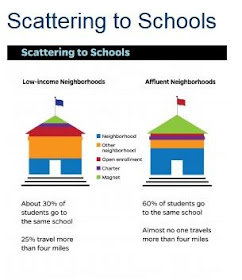No Zip Code Tyranny
A John Hopkins researcher says that the wealthy do not choose choice.
The conclusion comes from research by Julia Burdick-Will who has a joint appointment in Sociology and the School of Education. "Neighbors but not Classmates" has just been published, and while the conclusions we can draw from it are pretty narrow, it offers an interesting tidbit of anti-conventional wisdom.
Burdick-Will took a look at 24,000 rising ninth graders in Chicago. In neighborhoods with median income over $75,000, the students attended one of two or three schools. In neighborhoods with median income under $25,000, students were divied up among around thirteen different schools. This chart from the news release about the report pretty well gets the idea:

I find the travel distance most notable-- the more wealthy students get to stay close to home. The non-wealthy get to tromp all over the city. The average travel distance in wealthy neighborhoods was 1.7 miles, and in non-wealthy neighborhoods it was 2.7.
Burdick-Will gets in a couple of good quotes:
We think of children in poor neighborhoods as ‘stuck.’ But they’re not stuck in one geographic place. They’re stuck navigating a complicated and far-flung school system.
I see a couple of caveats for this report. One is that we're only looking at one high school grade, and only in Chicago. The much larger one is that we're looking at 2009. On the one hand, the landscape may have changed in some significant ways in the six years since then. On the other hand, as CURMUDGUCATION: No Zip Code Tyranny:
Don't Fix Your Building
Up a floor from the publishing offices of the Journal of Obvious Conclusions, we find the Journal of Dumb Questions, which probably wants dibs on this working paper from the National Bureau of Economic Research-- "Investing in Schools: Capital Spending, Facility Conditions, and StudentAchievement."
I should probably be less hard on these guys-- after all, they are economists. And this is exactly the kind of stupid question we'll waste time on as long as we think the purpose of schools is to "raise student achievement" (aka "get higher test scores").
Here's the premise:
Public investments in repairs, modernization, and construction of schools cost billions. However, little is known about the nature of school facility investments, whether it actually changes the physical condition of public schools, and the subsequent causal impacts on student achievement.
Yup. The roof in your school may be leaking, the bathrooms may be crumbling, and the heaters might not work, but before you go throwing a lot of money at the problems, let's ask the important question-- will fixing any of those things raise test scores?
The answer is, apparently, no. Now, I don't know how you pretend to research this. I could buy the paper on-line, but I can think of almost anything that might be a better use of my money (though I guess spending it on school improvement would not be on that list). The suggestion of the summary seems to be that they studied only schools that underwent big capital spending programs and looked to see if their students suddenly got better test scores. In related research, studies show that food
I should probably be less hard on these guys-- after all, they are economists. And this is exactly the kind of stupid question we'll waste time on as long as we think the purpose of schools is to "raise student achievement" (aka "get higher test scores").
Here's the premise:
Public investments in repairs, modernization, and construction of schools cost billions. However, little is known about the nature of school facility investments, whether it actually changes the physical condition of public schools, and the subsequent causal impacts on student achievement.
Yup. The roof in your school may be leaking, the bathrooms may be crumbling, and the heaters might not work, but before you go throwing a lot of money at the problems, let's ask the important question-- will fixing any of those things raise test scores?
The answer is, apparently, no. Now, I don't know how you pretend to research this. I could buy the paper on-line, but I can think of almost anything that might be a better use of my money (though I guess spending it on school improvement would not be on that list). The suggestion of the summary seems to be that they studied only schools that underwent big capital spending programs and looked to see if their students suddenly got better test scores. In related research, studies show that food
